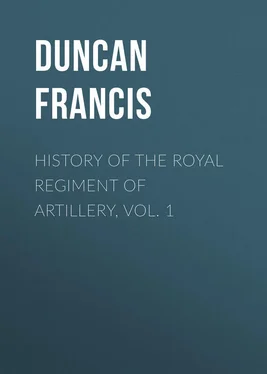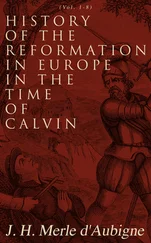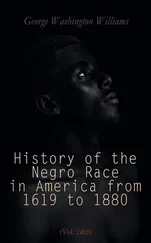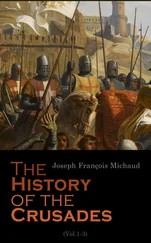Francis Duncan - History of the Royal Regiment of Artillery, Vol. 1
Здесь есть возможность читать онлайн «Francis Duncan - History of the Royal Regiment of Artillery, Vol. 1» — ознакомительный отрывок электронной книги совершенно бесплатно, а после прочтения отрывка купить полную версию. В некоторых случаях можно слушать аудио, скачать через торрент в формате fb2 и присутствует краткое содержание. Жанр: foreign_antique, foreign_prose, на английском языке. Описание произведения, (предисловие) а так же отзывы посетителей доступны на портале библиотеки ЛибКат.
- Название:History of the Royal Regiment of Artillery, Vol. 1
- Автор:
- Жанр:
- Год:неизвестен
- ISBN:нет данных
- Рейтинг книги:4 / 5. Голосов: 1
-
Избранное:Добавить в избранное
- Отзывы:
-
Ваша оценка:
- 80
- 1
- 2
- 3
- 4
- 5
History of the Royal Regiment of Artillery, Vol. 1: краткое содержание, описание и аннотация
Предлагаем к чтению аннотацию, описание, краткое содержание или предисловие (зависит от того, что написал сам автор книги «History of the Royal Regiment of Artillery, Vol. 1»). Если вы не нашли необходимую информацию о книге — напишите в комментариях, мы постараемся отыскать её.
History of the Royal Regiment of Artillery, Vol. 1 — читать онлайн ознакомительный отрывок
Ниже представлен текст книги, разбитый по страницам. Система сохранения места последней прочитанной страницы, позволяет с удобством читать онлайн бесплатно книгу «History of the Royal Regiment of Artillery, Vol. 1», без необходимости каждый раз заново искать на чём Вы остановились. Поставьте закладку, и сможете в любой момент перейти на страницу, на которой закончили чтение.
Интервал:
Закладка:
The difficulty of getting arms for the troops which were being raised for service in Ireland alarmed the Board greatly. Very strong measures had to be taken: penalties were threatened on every one who kept arms concealed, or failed to bring them to the Board; and a house-to-house search was authorized. Gunsmiths were forbidden to sell to private individuals, and commanded to devote all their energies to manufacturing arms for the Board, and yet the need was sore. Horses, also, had to be bought, and could with difficulty be obtained; and such as were procured could not bear the test of examination. So bad were they, that at last the Master-General inspected in person not merely the horses bought for the Artillery, but also the persons who bought them. At his first inspection he found them all faulty – rejecting some because they were too slight, some because they were lame, and one because it was an old coach-horse. With the difficulty of getting horses came also the difficulty of procuring forage. The contract for the horses of the Traynes for Chester and Ireland reached the unprecedented sum of fifteen pence per horse for each day.
To add to the other troubles of the new Board, the Chief Firemaster and Engineer (Sir Martin Beckman), with all the keenness and zeal of a renegade, kept worrying it about the state of the various Forts and Barracks; whose defects, he assured the Board, he had repeatedly urged on the two preceding monarchs, but without avail, on account of the deficiency of funds. "Berwick," he begged to assure the Board, "is getting more defenceless every year, and will take 31,000 l. to be spent at once to prevent the place from being safely insulted." For six years past he assured the Board that Hull had been going to ruin: the earthworks had been abused by the garrison, who had suffered all sorts of animals to tread down the facings, and had, in the night-time, driven in cattle, and made the people pay money before they released them; and when they turned the cattle and horses out, they drove them through the embrasures and portholes, and so destroyed the facings, that, without speedy repair and care, his Majesty would certainly be obliged to make new ones.
The bomb-vessels also occupied the attention of the Board. More practical Artillerymen were required than could be granted without greatly increasing the permanent establishment. So a compromise was made; and a number of men were hired and appointed practitioner bombardiers, at the same rate of pay as others of the same rank, viz. 2 s. per diem, but with the condition that the moment their services were no longer required they would be dispensed with.
There were calls, also, from the West Indies on the sore-pressed Board. A train of brass Ordnance was sent there, to which were attached the following, among other officials: – A Firemaster, at 10 s. a day; a Master-Gunner, at 5 s. ; Engineers, at various rates, but generally 10 s. , who were ordered to send home frequent reports and sketches; Bombardiers, at 2 s. 6 d. ; and a proportion of Gunners and Matrosses, at 2 s. and 1 s. 6 d. per diem respectively, whose employment was guaranteed to them for six months at least.
As if the Admiralty, the horsedealers, the West Indies, Scotland, Ireland, and unseasonable zeal were not enough, there must come upon the scene of the Board's deliberations that irrepressible being, the "old soldier." The first Board of William and Mary was generous in its dealings with its officials almost to a fault. This is a failing which soon reaches ears, however distant. Several miners absent in Scotland, hoping that in the confusion the vouchers had been mislaid, complained that they were in arrears of their pay, "whereby," said the scoundrels, "they were discouraged from performing their duties on this expedition." Enquiries were made by the Board, and in the emphatic language of their minute, it was found "that they lied , having been fully paid up."
When the time came for the Duke to shake off the immediate worries of the office, as he proceeded to Chester and to Ireland, his relief must have been great. With him he took the chief waggon-master to assist in the organization of the train in Ireland, leaving his deputy at the Tower to perform his duties. The suite of the Master-General on his ride to Chester included six sumpter mules with six sumpter men, clad in large grey coats, the sleeves faced with orange , and "the coats to be paid for out of their pay."
Only two more remarks remain to be made. The proportion of drivers to the horses of William's train of Artillery in Ireland may be gathered from an order still preserved directing a fresh lot of horses and men to be raised in the following proportions: one hundred and eighty horses; thirty-six carters, and thirty-six boys.
Next, the dress of the train can be learned from the following warrant, ordering: —
"That the gunners, matrosses, and tradesmen have coates of blew, with Brass Buttons, and lyned with orange bass, and hats with orange silk Galoome. The carters, grey coates lyned with the same. That order be given for the making of these cloaths forthwith, and the money to be deducted by equal proportions out of their paye by the Treasurer of the Trayne."
(Signed) "Schomberg."
From a marginal note, we learn that the number of gunners and matrosses with the train was 147, and of carters, 200; these being the numbers of suits of clothes respectively ordered.
It was with this train to Ireland that we find the first notice of the kettledrums and drummers ever taking the field. 7 7 Miller.
CHAPTER IV.
Landmarks
In the chaotic sea of warrants, correspondence, and orders which represents the old MSS. of the Board of Ordnance prior to the formation of the Royal Regiment of Artillery, there are two documents which stand out like landmarks, pointing to the gradual realization of the fact that a train of Artillery formed when wanted for service, and disbanded at the end of the campaign, was not the best way of making use of this arm; and that the science of gunnery, and the technical details attending the movement of Artillery in the field, were not to be acquired intuitively, nor without careful study and practice during time of peace.
The first relates to the company of a hundred fee'd gunners at the Tower of London, whose knowledge of artillery has already been described as most inadequate, and whose discipline was a sham. By a Royal Warrant dated 22nd August, 1682, this company was reduced to sixty in number by weeding out the most incapable; the pay, which had up to this time averaged sixpence a day to each man, was increased to twelve-pence; but in return for this augmentation, strict military discipline was to be enforced; in addition to their ordinary duties at the Tower, they were to be constantly exercised once a week in winter, and twice a week in summer by the Master-Gunner of England; they were to be dismissed if at any time found unfit for their duties; and a blow was struck at the custom of men holding these appointments, and also working at their trades near the Tower, by its being distinctly laid down that they were liable for duty not merely in that Fortress, but also "in whatever other place or places our Master-General of the Ordnance shall think fit."
This was the first landmark, proclaiming that a nucleus and a permanent one of a trained and disciplined Artillery force was a necessity. Money was not plentiful at the Ordnance Board under the Stuarts, as has already been stated; so as time went on, and it was found necessary to increase the educated element, – the fireworkers, petardiers, and bombardiers, – it was done first by reducing the number of gunners, and, at last, in 1686, by a grudgingly small increase to the establishment.
Читать дальшеИнтервал:
Закладка:
Похожие книги на «History of the Royal Regiment of Artillery, Vol. 1»
Представляем Вашему вниманию похожие книги на «History of the Royal Regiment of Artillery, Vol. 1» списком для выбора. Мы отобрали схожую по названию и смыслу литературу в надежде предоставить читателям больше вариантов отыскать новые, интересные, ещё непрочитанные произведения.
Обсуждение, отзывы о книге «History of the Royal Regiment of Artillery, Vol. 1» и просто собственные мнения читателей. Оставьте ваши комментарии, напишите, что Вы думаете о произведении, его смысле или главных героях. Укажите что конкретно понравилось, а что нет, и почему Вы так считаете.












